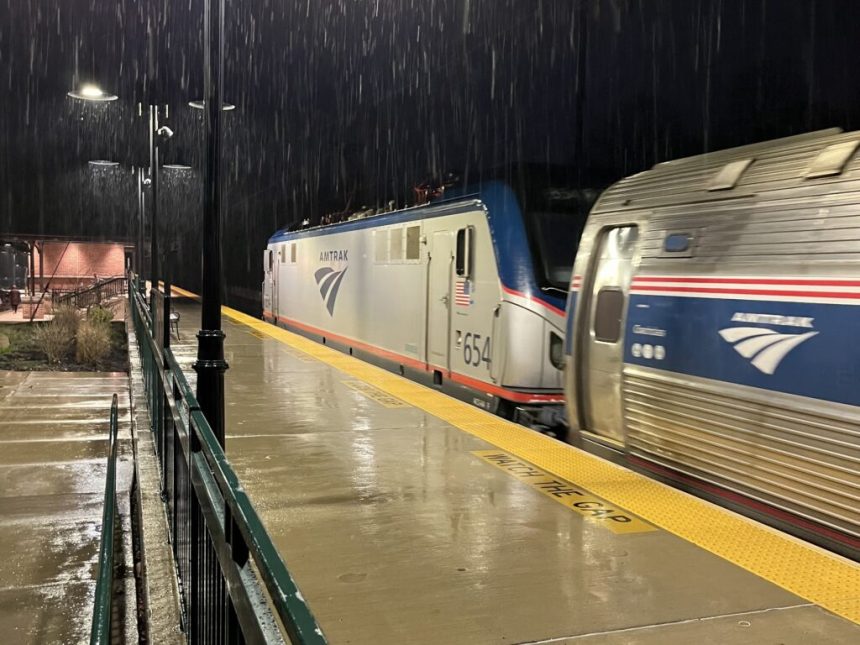Amtrak’s Keystone Service train at Exton station in Chester County. (Peter Hall/Capital-Star)
A crucial passenger rail link between central Pennsylvania, Philadelphia and New York could be in jeopardy if state lawmakers don’t act to stave off public transit cuts in the commonwealth’s largest metro area, U.S. Rep. Brendan Boyle (D-2nd District) said Monday.
Boyle said Amtrak President Roger Harris told him the loss of more than $71 million in payments from the Southeastern Pennsylvania Transportation Authority (SEPTA) would severely impact Amtrak’s operations, possibly leading to the suspension of the Keystone Service.
“Many people in our area rely on the Keystone Service. If SEPTA cuts or eliminates that funding to Amtrak, that rail line will cease to operate,” Boyle said in a call with reporters Monday.
The train makes 13 daily round trips between Harrisburg and New York with stops in Lancaster, and several smaller communities in southcentral and southeastern Pennsylvania, in addition to Philadelphia. The trains, which are primarily funded by PennDOT, carried 1.27 million passengers last year, according to Amtrak. That makes the Keystone the railroad’s fifth-busiest service.
SUPPORT: YOU MAKE OUR WORK POSSIBLE
Amtrak officials did not immediately respond to a request for comment.
Facing a $213 million deficit, SEPTA plans to reduce or eliminate service throughout its system. The cuts could begin as soon as next week if the legislature is unable to increase public transit funding in the state budget, which is now more than six weeks overdue. The reductions could impact up to 800,000 people who use the transit system daily.
The cuts to bus and rail service include the elimination of SEPTA’s regional rail routes that operate on lines owned by Amtrak. They include the Northeast Corridor between New York and Washington and the Keystone Corridor between Philadelphia and Harrisburg.
SEPTA contributed $42.3 million for capital projects including track and signal improvements and $28.8 million in operating expenses including policing and station operations, according to Boyle’s office.
By eliminating five commuter rail services that use Amtrak’s lines, SEPTA can put the cost savings toward its structural deficit, spokesman Andrew Busch said. While service on the remaining eight commuter lines is slated to be reduced by 45%, SEPTA owns those rails and would not see comparable savings by cutting them entirely.
“SEPTA does not know how the elimination of regional rail service on Amtrak-owned lines will impact Keystone Line service,” Busch said. “We understand that Amtrak will have to make decisions in the coming weeks whether to pause or postpone infrastructure projects on the Keystone Line in response to the planned elimination of SEPTA’s lease payments on Jan. 1.”
It’s also unclear whether the loss of SEPTA’s payments would affect Amtrak’s once-daily Pennsylvanian Service between Philadelphia and Pittsburgh. In 2023, the state won a federal grant to make improvements to tracks owned by Norfolk Southern Corp. to allow a second daily Pennsylvanian run.
Passengers board an Amtrak train at Harrisburg’s station. (Capital-Star/Peter Hall)
PennDOT officials did not respond to a request for comment Monday.
While cuts to Amtrak service are not a certainty even if SEPTA makes its planned cuts, the possibility shows how the public transportation crisis “puts tens of millions of dollars in serious jeopardy for the operation of Amtrak in our regions,” Boyle said.
“It’s yet one more reason why the SEPTA funding crisis needs to end,” he said.
While SEPTA is the state’s largest mass transit agency, public transportation providers in every county have faced a financial crisis since ridership dropped precipitously during the COVID-19 pandemic. With a larger number of people working remotely since then, revenue from fares has not returned to pre-pandemic levels.
At the same time, lawmakers have struggled to find reliable sources of funding for transportation generally as more fuel-efficient vehicles and the proliferation of electric vehicles have chipped away at fuel tax revenue.
It has also highlighted the duality of the commonwealth’s urban and rural divide. Republican lawmakers have opposed more funding for transit without additional money for roads, bridges and other transportation infrastructure such as regional airports that serve rural districts.
SUBSCRIBE: GET THE MORNING HEADLINES DELIVERED TO YOUR INBOX
Gov. Josh Shapiro has proposed increasing the state’s contribution of sales tax revenue to public transportation in his last two budgets to provide about $300 million more for transit. Last year, however, the compromise budget included only $80 million in additional money for transit. Shapiro redirected $153 million in federal highway funding to keep SEPTA afloat.
Despite a flurry of activity last week, the impasse between the Democratic-controlled House and Republican-led Senate appears no closer to breaking.
House Democrats shot down a $47.6 billion budget proposal Wednesday that had cleared the GOP-controlled Senate late the night before by a party line vote, effectively prolonging the stalemate.
The Senate’s proposal is about $3 billion less than the one that passed the House last month. The big differences include how to fund public education and different mechanisms for public transportation funding.









